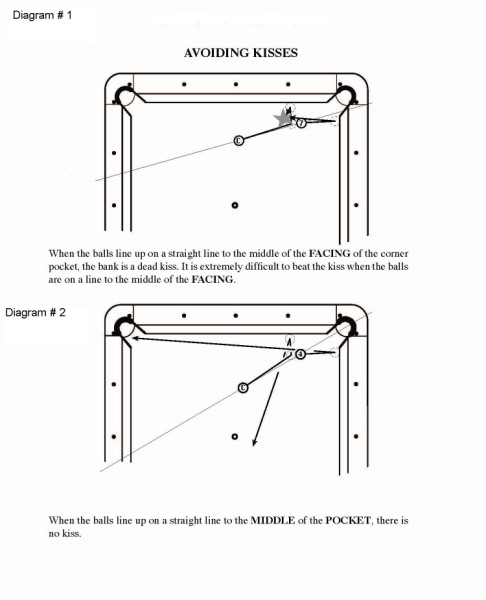How do you know if a bank shot will cause a double-kiss, and how can you avoid it?
The video demonstrates an easy method to detect and avoid cross-over bank double kisses:
Obviously, if the pocket is really big or really small, the facing is in slightly different positions, so the double-kiss facing rule is slightly different for different size pockets, but not by much. Results also depend on table conditions, so it is important to practice it on a particular table. The OB distance from the rail is also important concerning what can and can’t be done with spin to avoid the double kiss.
These videos show several techniques to avoid a double kiss with cross-side and cross corner bank shots:
These videos show how to detect a double kiss when banking a ball frozen or close to the rail:
Here’s an excerpt from Vol. IV of the Video Encyclopedia of Pool Practice (VEPP) showing how to use speed and transferred spin to avoid double kisses:
The classic one-pocket straight-back bank in NV H.2 – Bending, Twisting, and Stiffening Kick and Bank Shots is another good example of how to avoid a double kiss. You can also hop the OB into the cushion to help jump over the CB to avoid a double kiss.
Here’s a good article from Bob Jewett (BD, July ’99) covering how to detect and avoid double kisses.
These videos show some examples of how to use a double-kiss bank to your advantage:
And here are some interesting frozen-ball shots relying on cushion compression and double kisses:
Here’s another somewhat-unusual example of a double-kiss bank shot:
For more examples of useful double-kiss shots, see herd shots.
from freddy the beard:
Determining whether a bank shot lays in the “kiss” zone is often misunderstood, and usually winds up as an educated guess. In the following diagrams I have outlined exactly when a bank cannot normally be made using a rolling with or without english. In diagram #1, I deal with the shorter angle cross-corners. If the straight-in angle of the cueball and object ball is lined up and aiming into the pocket facing, the shot is a certain kiss. Left or right english, follow, center, or draw is not going to help you beat that kiss. With a slight angle adjustment, as per diagram #2, lined up to the middle of the back of the pocket, the bank can now be easily made with rolling or center ball, no english.
Diagram #3 is another variation that must be considered. It involves crossing, or passing-over, the object ball from a much more severe angle. Rather than calculate off of a straight-in angle as per dia.#1 & 2, the kiss/no kiss reference point is determined by lining up the actual cut angle needed to make the bank. If an imaginary line from the center of the cueball, extending thru the cut area on the object ball, continues into the middle of the back of the pocket, the kiss is “on.” If the line instead, is aiming at the short/bottom rail, you can go ahead and shoot the shot with impunity. Provided of course you are using a natural rolling ball, center ball, left english in this case, or draw. Right hand english when the bank is “on” could result in a kiss.


Dr. Dave keeps this site commercial free, with no ads. If you appreciate the free resources, please consider making a one-time or monthly donation to show your support:
